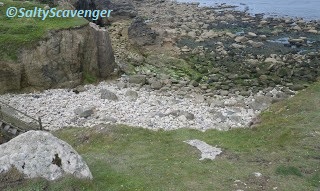The bay experiences a dynamic regime, alternating between periods of erosion (stony) and deposition (sandy).The underlying substrate is boulders and bedrock, however, variable amounts of sand may be deposited on top, sourced from the sand bar situated offshore. The communities encountered reflect the alternation between these regimes.
Please see previous blog posts:
http://thesaltyscavenger.blogspot.co.uk/2016/06/rockpooling-destination-lands-end.html
http://thesaltyscavenger.blogspot.co.uk/2016/06/rockpooling-destination-lands-end.html
http://thesaltyscavenger.blogspot.co.uk/2015/10/rockpooling-destination-revisit-to.html
http://thesaltyscavenger.blogspot.nl/2015/07/rockpooling-destination-revisit-lands.html
http://thesaltyscavenger.blogspot.nl/2014/05/revisit-lands-end-peninsular-april-2014.html
http://thesaltyscavenger.blogspot.nl/2014/02/rockpooling-destination-lands-end.html
http://thesaltyscavenger.blogspot.nl/2014/02/rockpooling-destination-lands-end.html
For the past 21 months the shore has been stony and a series of rockpooling visits has documented the slow colonisation and succession of the sea shore communities of the newly available substrate. Now the shore is experiencing increased sand deposition which is influencing the communities previously documented. Notably, increased sand deposition and reduced seaweed cover and the infill of many of the sediment filled rockpools.
Below are images showing the change in sediments and habitats observed since April 2015/ March 2016.
 |
This photograph taken in September 2015 shows the typical Fucoid and ephemeral seaweed communities that covered the bedrock and boulders of the shore which has now been mostly covered by sand.
|
Sand continues to be deposited on the shore, covering the fucoid habitat.
Ephemeral seaweeds such as Porphyra sp cover rocks of the lower shore.








